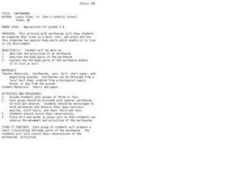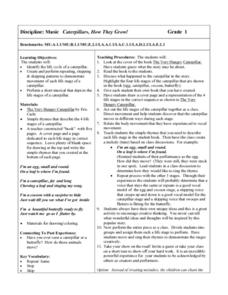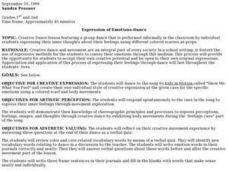Curated OER
Copy Cat
Students follow the directions as the "cat" guides them in moving creatively. In this observing and listening lesson, students move their bodies while staying in their own spaces. Students then are allowed to move out of their space and...
Curated OER
The Magic School Bus Flexes Its Muscles
Students learn along with Ms. Frizzle's class. In this Magic School Bus lesson plan, students explore the inside of the human body as they compare the bones and joints of a chicken wing with their own hands and arms.
Curated OER
Earthworms
Students observe and chart the body of earthworms. For this earthworm lesson plan, students each get their own earthworm to observe and play with. They then record the different body parts of an earthworm and the different behaviors they...
Curated OER
Head, Shoulders, Knees and Toes
Students gain a greater comprehension of the anatomy and physiology of the muscular system, the skeletal system and connective tissue by researching joints in the body. They also reflect on the effects of injuries on their joints and...
Curated OER
Animals in Action
Students role play the movements that animals make to discover the importance of exercise in staying healthy and having energy. They mimic the hopping of kangaroos and the balancing of flamingos as they watch the animals perform these...
Curated OER
Ourselves
Students identify the main parts of the human body. They point to various parts of their own body, cut out pictures of humans and animals and sort them into the two categories, discuss the differences between animals and humans, and...
Curated OER
EXPLORING OUR HUMAN BODIES
Students observe and investigate the human skeletal and muscle systems. They become aware of the versatility of movement as well as gain experience through the use of diagrams and hands on activities. An extensive vocabulary is covered...
Curated OER
The Human Body Systems - Lesson Plan
Students identify the following organ systems in the human body and state their functions: muscular, skeletal, circulatory, respiratory, digestive.
Curated OER
Music: Caterpillars, How They Grow!
Put on some music and get moving as a way to represent the life cycle of a caterpillar. Kids listen to the story The Very Hungary Caterpillar, discuss the life cycle, then create vocal expression that represent each stage of the cycle....
Curated OER
Keeping Healthy
A helpful presentation highlights the importance of exercise, and focuses on how muscles move when we move our bodies. The last two slides invite learners to create a brochure that promotes the benefits of a certain sport on the body,...
Serendip
How Do Muscles Get the Energy They Need for Athletic Activity?
Every muscle movement requires energy, but where does that energy come from? Scholars answer this question and more as they complete a worksheet. By following the directions, completing research, and discussing it as a class, they begin...
Blogspot
Children Moving
Running, jumping, walking, leaping! Display this image of characters performing dynamic movements, and encourage your learners to have active and healthy bodies!
Curated OER
To Travel or Not to Travel: Locomotor andNonLocomotor Movement
Students develop dances. In this movement lesson, students play action and stillness games and learn motif writing symbols that communicate dance moves. Students use locomotor and non-locomotor movement to create their own movement phrases.
Curated OER
Motor Skills and Movement Patterns
Students explore the human body by participating in physical activities. In this physical education lesson, students demonstrate their physical prowess and motor skills by performing tasks such as climbing and rope tying. Students...
Curated OER
The Full Bodied Romeo
Students put physical movement to the word of Romeo's ozymoronic speech in order to explain the trauma that he is experiencing.
Curated OER
Body Defense and Disease
In this body defense and disease activity, students complete two multiple step questions about infectious diseases and how they are passed.
Curated OER
Dancing through Poetry
Get your class up and moving as they explore how to express movement and dance through words. Designed around two poems by Lillian Morrison about break dancing, the activity truly captures the creative and multi-sensory aspects of...
Curated OER
Dance the Beat
Students study the artwork of Keith Haring to identify his style and techniques used to represent movement of the human body. They observe each other's movements while dancing to lively music. Students represent each other's postures and...
Curated OER
Expression of Emotions-Dance
Pupils dance to the song by Kids in Motion called "Show Me What You Feel" and create their own individual style of creative expression at the given cues for the specific emotions using a colored scarf and body movements.
Curated OER
Rhythmic Pattern and Movement
Students practice repeating rhythmic patterns in unison. Next, students work in groups to practice an alternate rhythmic pattern to Row, Row, Row Your Boat. They create their own rhythmic patterns for the song.
Curated OER
How Food Moves Through the Body
In this food and digestion worksheet, students read a short article the digestive system and choose the multiple choice answer for 11 questions. Students also put the organs that food moves through in the correct sequential order.
Curated OER
Rainy Day? P.E. Anyway!
If your PE class is faced with bad weather and must stay indoors, try one of these activities to keep them engaged and moving! Activities involve working in teams, identifying sports or parts of the body, coordination practice, and/or...
Curated OER
Roger Robot
Read the story of Roger Robot included in the lesson and have kids move creatively by interpreting how a robot might move. Read a part of the story, then stop and let the class act it out. Read some more, and let them move some more....
University of Minnesota
Virtual Neurons
It's electric! Young anatomists use Virtual Neurons software to build, control, and analyze complex nerve circuits within the body. Colorful and packed with content, class members enjoy interacting with the nervous system...























